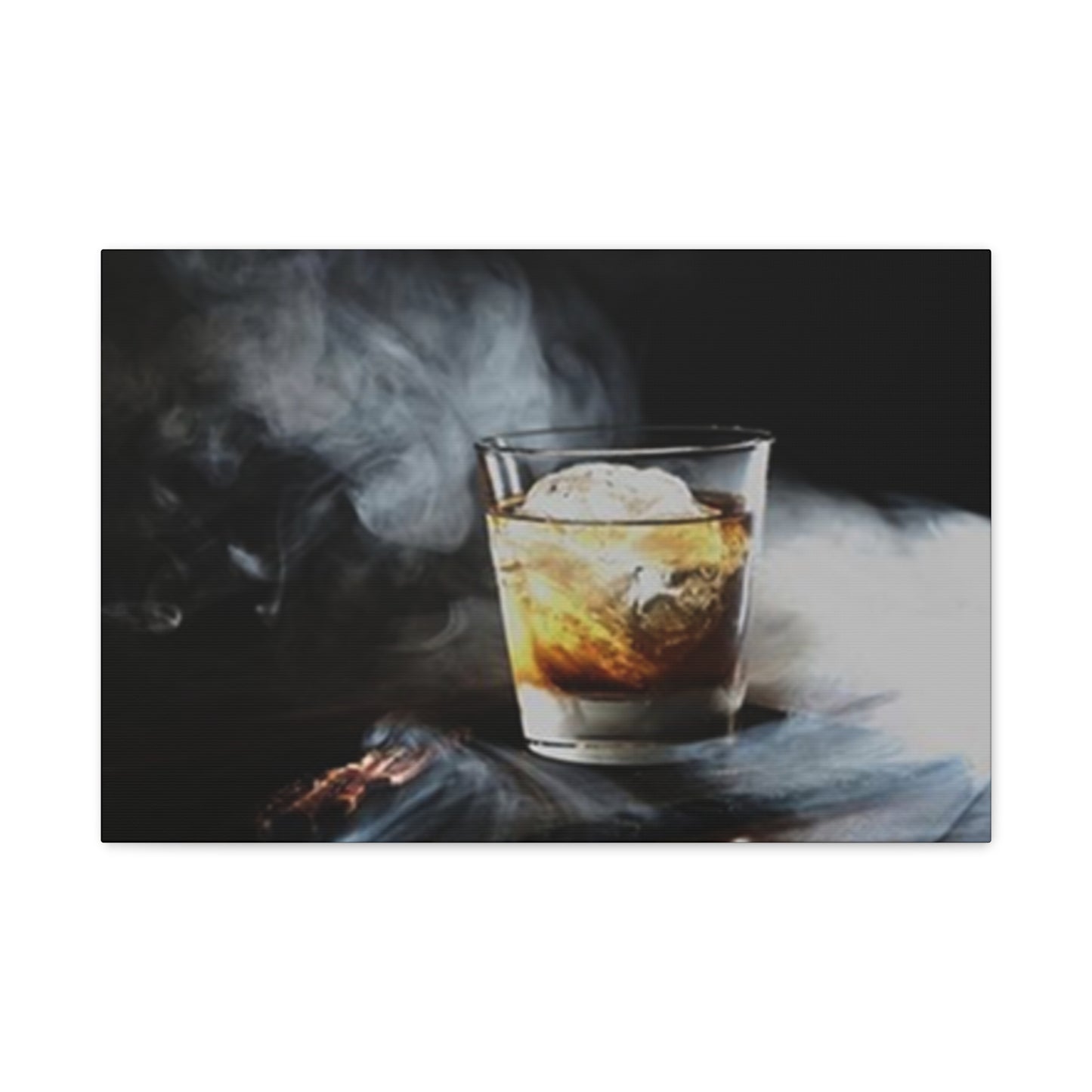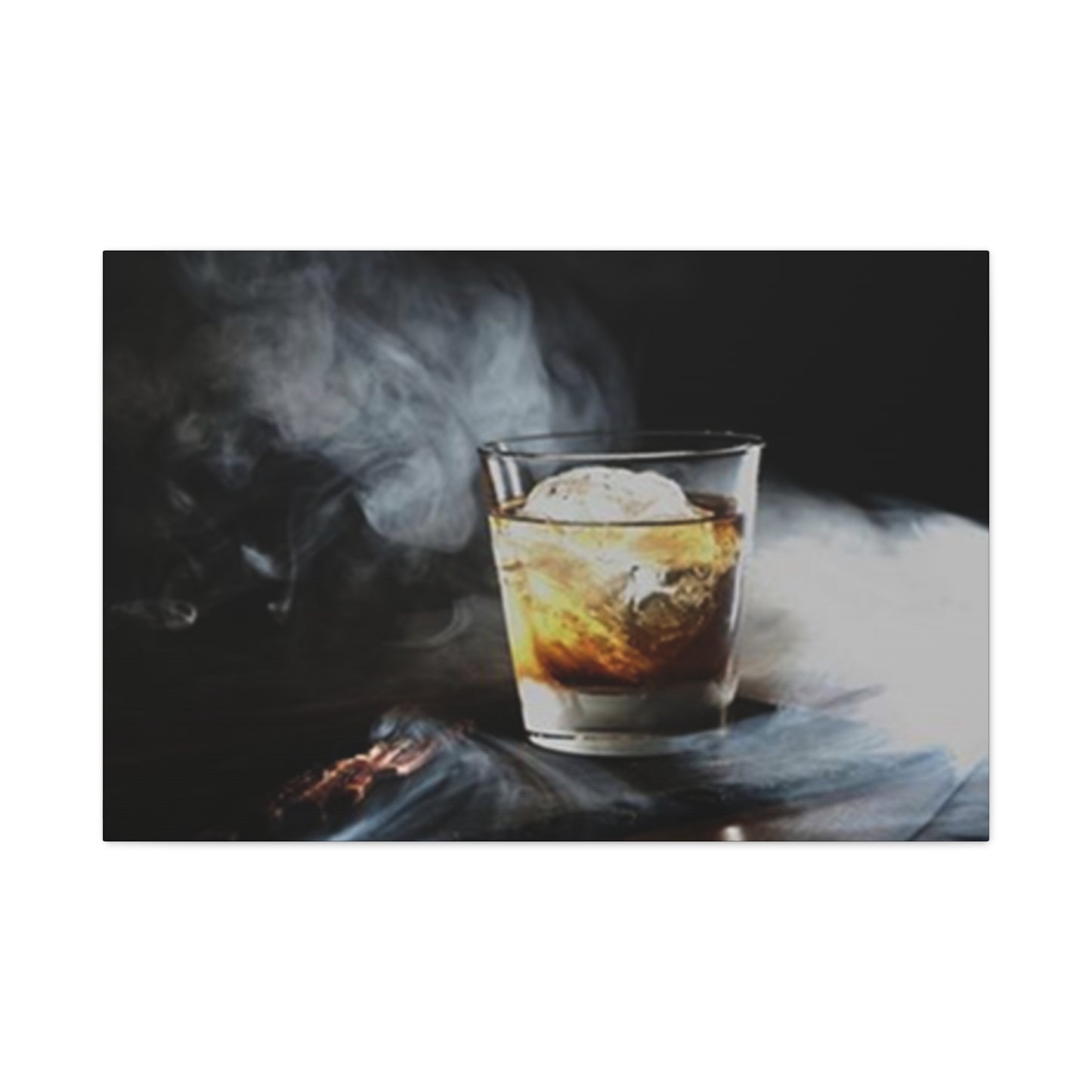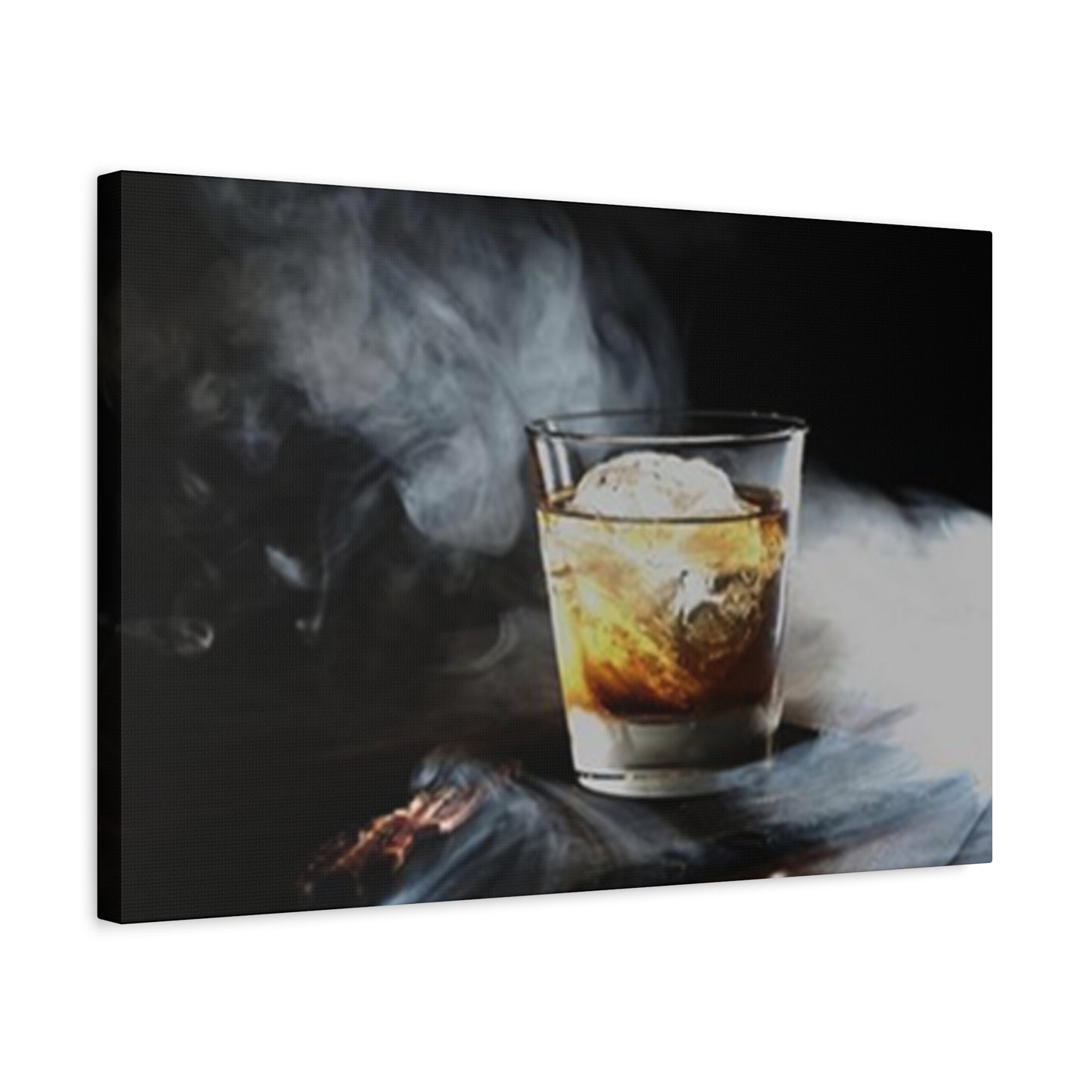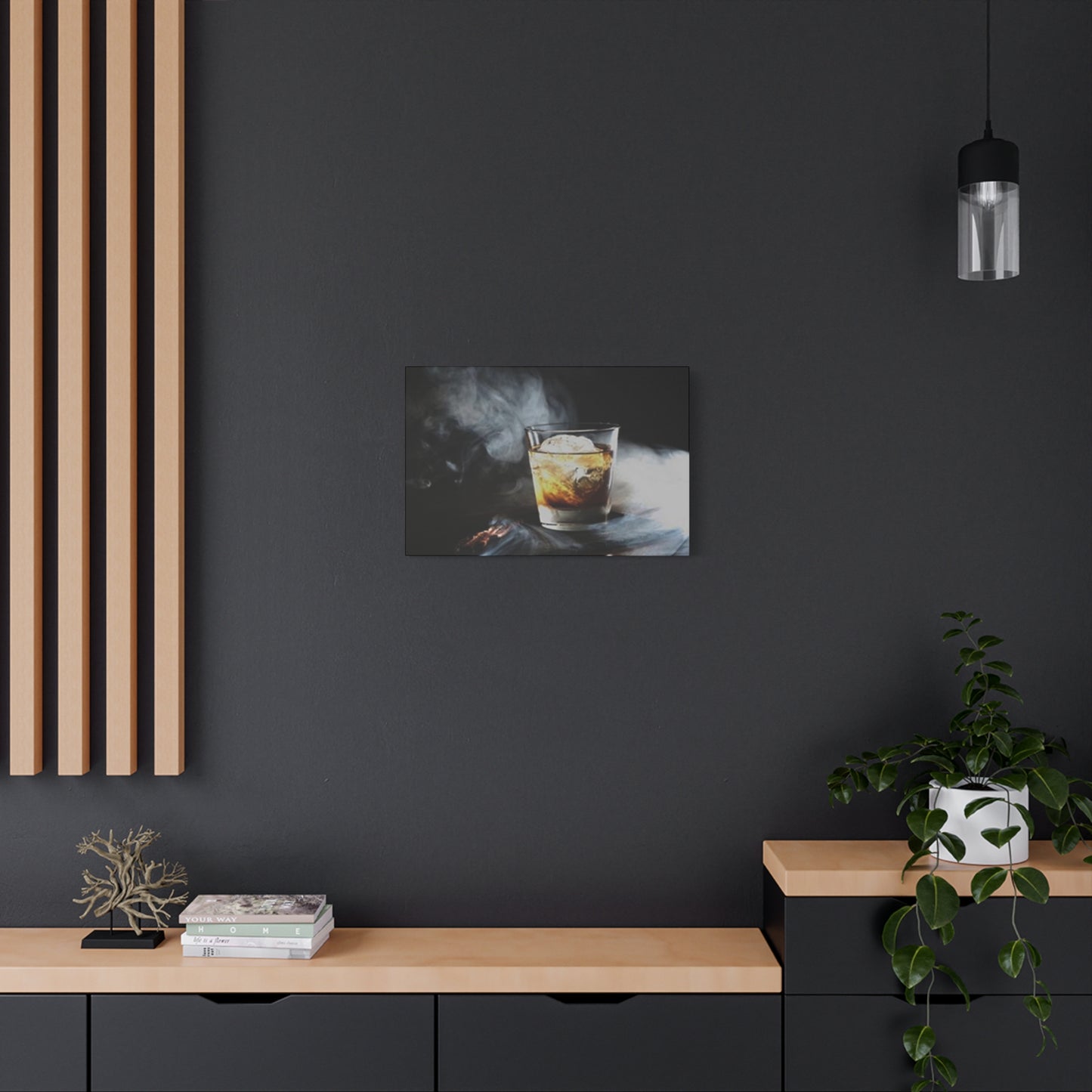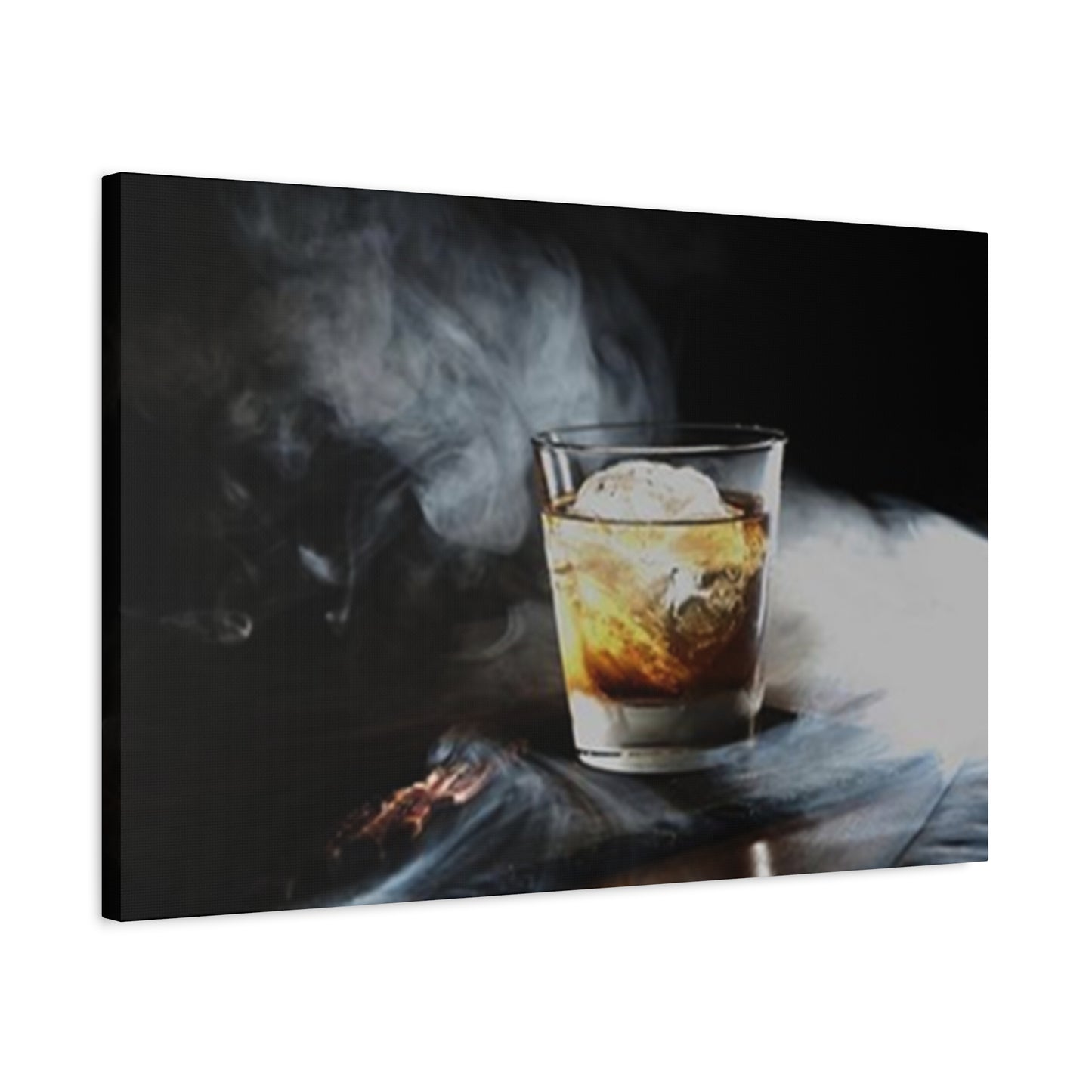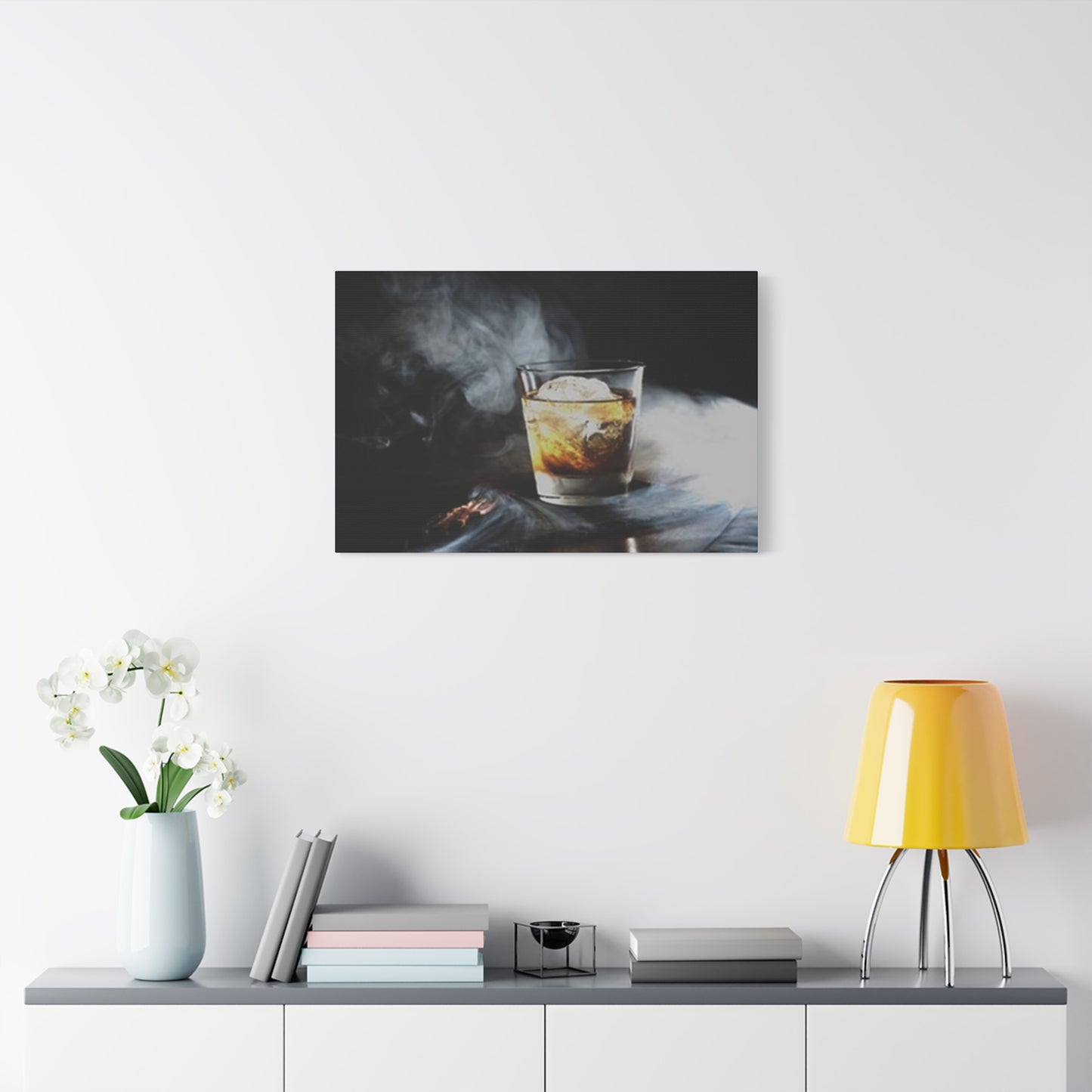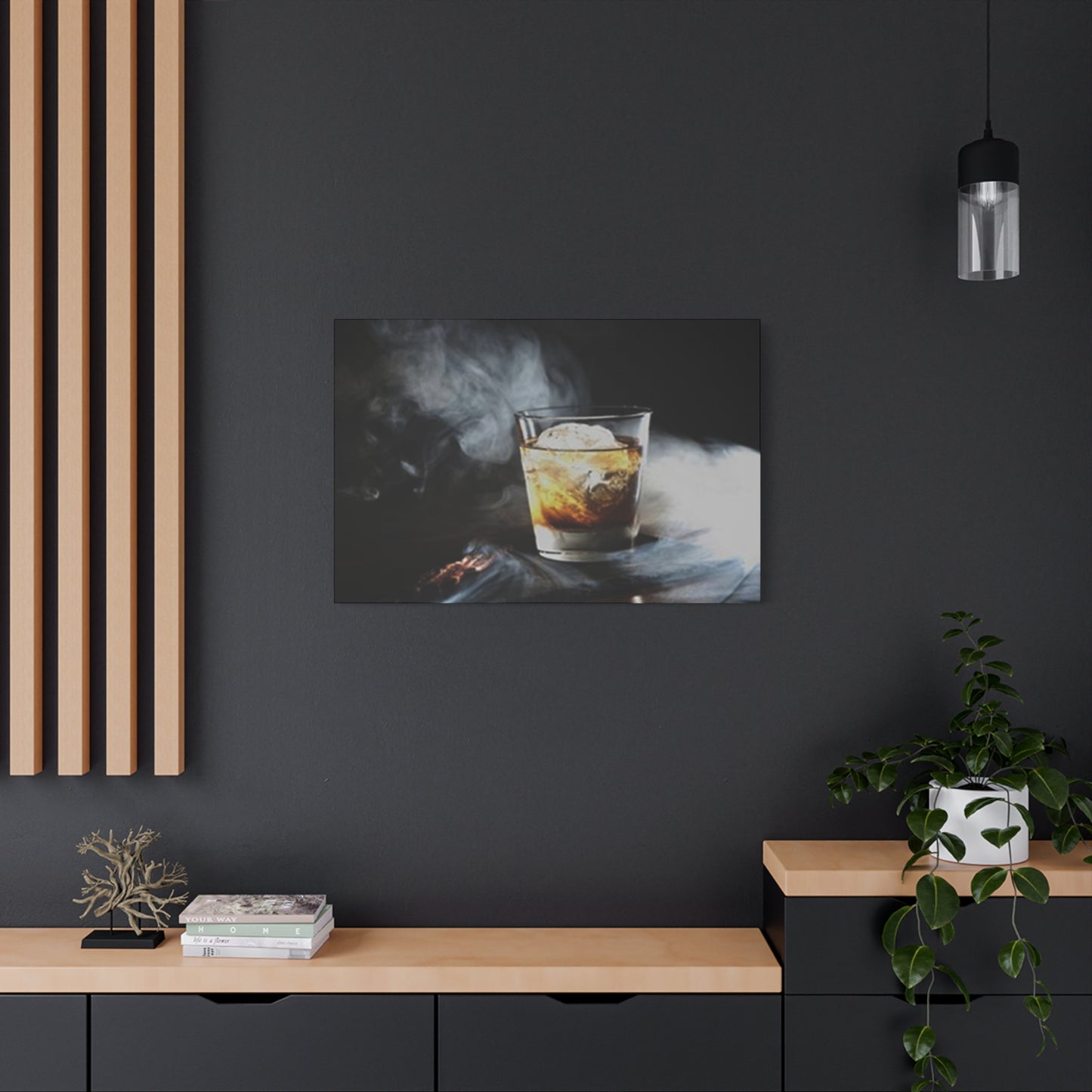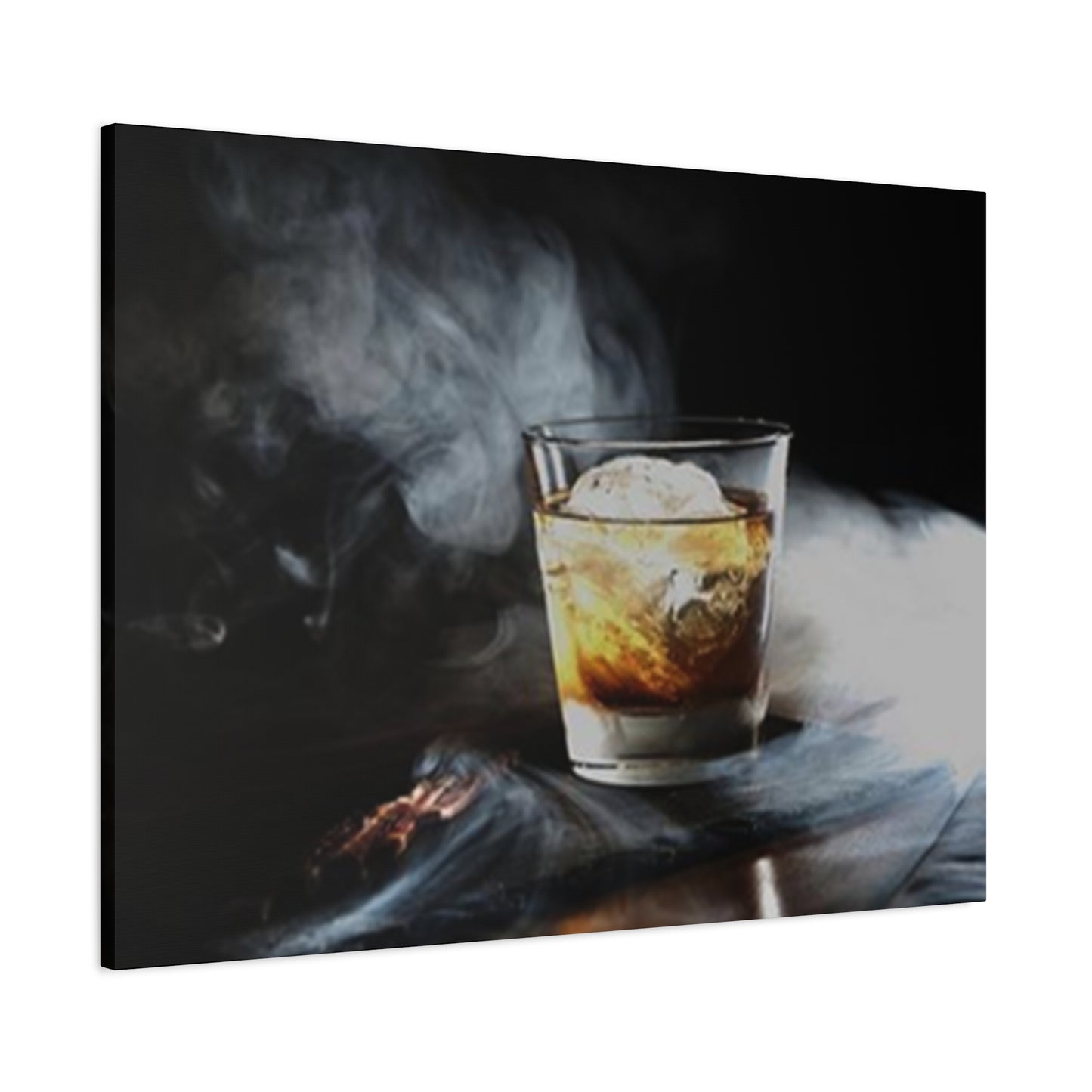Whiskey in Smoke Wall Art: Premium Decorative Ideas for Your Space
Whiskey in smoke wall art represents a mesmerizing fusion of two powerful visual elements that have captivated human imagination for centuries. This artistic style captures the essence of sophistication, mystery, and timeless elegance in a single frame. The swirling patterns of smoke intertwined with the rich amber tones of whiskey create a dramatic visual narrative that speaks to enthusiasts of fine spirits and art lovers alike.
The beauty of this decorative approach lies in its ability to evoke multiple sensations simultaneously. When you observe a piece featuring whiskey surrounded by ethereal smoke wisps, you're not just looking at a picture but experiencing a moment frozen in time. The translucent quality of smoke contrasts beautifully with the deep, warm hues of aged whiskey, creating layers of depth that draw the eye deeper into the composition.
These artworks often incorporate dramatic lighting techniques that highlight the transparency and color gradations within the whiskey glass while simultaneously capturing the delicate, ever-changing nature of smoke. The interplay between solid and ephemeral, between the tangible liquid and the ghostly vapor, creates a philosophical dimension that elevates these pieces beyond mere decoration.
For those who appreciate the ritual of enjoying a fine whiskey, this art form resonates on a personal level. It captures the contemplative atmosphere of sipping a well-aged spirit, the quiet moments of reflection that accompany the experience, and the sophisticated ambiance that whiskey culture embodies. The smoke element adds an additional layer of mystery and allure, suggesting warmth, comfort, and the transformative nature of fire and spirit.
The Artistic Appeal Behind Smoke and Whiskey Imagery
The combination of smoke and whiskey in artistic representations carries profound symbolic weight that extends far beyond surface aesthetics. This pairing taps into deep cultural associations with masculinity, refinement, contemplation, and the passage of time. Artists who work with these subjects understand that they're not simply depicting objects but rather capturing a lifestyle, a philosophy, and a set of values that resonate with their audience.
Smoke has long been used in photography and art to represent the intangible aspects of human experience. It symbolizes transformation, the ephemeral nature of existence, and the beauty found in impermanence. When captured at the right moment, smoke forms intricate patterns that can never be exactly replicated, making each image inherently unique. This uniqueness appeals to collectors and decorators who value originality in their living spaces.
Whiskey, on the other hand, represents patience, craftsmanship, and the rewards of time well spent. The aging process that creates fine whiskey mirrors the maturation of character and wisdom in human life. The rich amber and golden tones of whiskey are naturally warm and inviting, creating an immediate sense of comfort and luxury in any space where they appear. When artists capture whiskey in glass, they're highlighting transparency, clarity, and the interplay of light through liquid.
Together, these elements create a powerful visual metaphor for balance between the fleeting and the enduring, the visible and the mysterious. The artwork becomes a conversation starter, inviting viewers to contemplate deeper meanings while simply enjoying the aesthetic beauty of the composition. This duality makes whiskey in smoke wall art particularly versatile for various interior design schemes.
Different Styles of Whiskey in Smoke Wall Decorations
The market for whiskey in smoke wall art offers an impressive variety of styles to suit different tastes and interior design preferences. Modern minimalist interpretations focus on clean lines, high contrast between light and dark elements, and simplified compositions that emphasize the essential beauty of the subject matter. These pieces work exceptionally well in contemporary spaces with sleek furniture and neutral color palettes.
Vintage-inspired designs draw from classic advertising aesthetics, incorporating retro typography, distressed textures, and nostalgic color schemes that evoke speakeasies and prohibition-era glamour. These artworks add character and historical depth to spaces that celebrate traditional craftsmanship and timeless design principles. They often feature ornate frames or are printed on materials that enhance their aged appearance.
Photorealistic approaches capture every detail with stunning clarity, from the condensation on a glass to individual smoke tendrils curling through space. These highly detailed pieces showcase technical mastery and provide almost tactile viewing experiences. They appeal to those who appreciate precision and want artwork that commands attention through its sheer virtuosity.
Abstract interpretations take creative liberties with the subject matter, using whiskey and smoke as starting points for explorations of color, form, and emotion. These pieces might blur the boundaries between recognizable elements, creating dreamlike compositions that evoke feelings rather than depicting literal scenes. They work beautifully in eclectic spaces where artistic expression takes precedence over conventional representation.
Choosing the Perfect Size for Your Wall Space
Selecting the appropriate dimensions for your whiskey in smoke wall art requires careful consideration of both the physical space and the visual impact you wish to achieve. Large-scale pieces ranging from four to six feet in width create dramatic focal points that immediately command attention when someone enters a room. These substantial artworks work best in spacious areas like living rooms, dining rooms, or home bars where they have enough breathing room to make their full impact.
Medium-sized pieces measuring between two to four feet offer versatility and can anchor various spaces without overwhelming them. These dimensions work particularly well above furniture pieces like sofas, consoles, or bar carts, creating visual connections between the artwork and the functional elements below. Medium pieces also allow for creative arrangement possibilities, such as pairing two complementary images side by side or creating gallery wall compositions.
Smaller artworks under two feet provide accent opportunities and work beautifully in intimate spaces like home offices, reading nooks, or powder rooms. Despite their modest size, well-chosen small pieces can pack significant visual punch through compelling composition and striking imagery. They also offer budget-friendly options for those beginning to build their art collections or wanting to test a design direction before committing to larger investments.
When evaluating size, consider the viewing distance typical for the space. Artwork in areas where people pass by quickly can be larger and bolder, while pieces in spaces meant for close contemplation might benefit from smaller dimensions that reveal intricate details upon closer inspection. The relationship between wall size and artwork dimensions follows design principles that suggest leaving adequate negative space around pieces to let them breathe visually.
Color Schemes That Complement Whiskey and Smoke Art
The natural color palette of whiskey in smoke artwork centers around warm amber, golden brown, and honey tones contrasted against deep blacks, charcoal grays, and smoky whites. These inherent colors provide a foundation that influences the broader color scheme of any room featuring such pieces. Rooms with neutral base colors like beige, cream, taupe, or various shades of gray provide the perfect backdrop that allows the artwork's natural warmth to shine.
Deep, rich accent colors enhance the luxurious feel that whiskey imagery naturally conveys. Navy blue walls create striking contrast with amber whiskey tones while maintaining sophistication. Forest green adds an elegant, classic library atmosphere that pairs beautifully with the traditional associations of fine spirits. Burgundy or wine-colored accents echo the depth and complexity of aged whiskey while creating a cohesive color story throughout the space.
For those preferring lighter, airier environments, working with the smoky elements in the artwork provides direction. Pale grays, soft whites with warm undertones, and cloud-like shades create harmony with smoke imagery while keeping spaces feeling open and fresh. These lighter schemes work particularly well in smaller rooms where darker colors might feel oppressive, allowing the artwork to provide the depth and visual weight the space needs.
Metallic accents in gold, brass, copper, or bronze create natural bridges between whiskey art and the surrounding decor. These finishes reflect light similarly to how whiskey catches and refracts illumination, creating subtle visual echoes that tie the design together. Incorporating these metals through light fixtures, hardware, frames, or decorative objects reinforces the premium, refined atmosphere that whiskey in smoke artwork establishes.
Materials and Printing Techniques for Quality Results
Canvas prints remain among the most popular choices for whiskey in smoke wall art due to their textured surface that adds depth and dimension to images. High-quality canvas provides durability while offering a sophisticated, gallery-worthy appearance. The texture helps diffuse light across the image, reducing glare issues common with glossy surfaces. Canvas prints typically arrive ready to hang with gallery-wrapped edges, eliminating the need for additional framing.
Metal prints represent a modern alternative that delivers stunning vibrancy and exceptional durability. The process of infusing dyes directly into specially coated aluminum creates images with remarkable color saturation and sharpness. Metal prints work particularly well for whiskey and smoke imagery because they enhance contrast and make dark blacks truly dramatic while bringing out subtle gradations in amber tones. The sleek, contemporary appearance suits modern interior designs.
Acrylic prints offer a premium option that creates incredible depth through multiple layers. When images are printed on acrylic or mounted behind it, the material's transparency and light-refracting properties give photographs almost three-dimensional quality. For whiskey and smoke subjects, this depth enhancement mimics the way light travels through actual whiskey in glass, creating remarkably lifelike results. The glossy finish adds luxury and works best in well-lit spaces.
Framed paper prints using archival-quality materials provide traditional elegance and maximum flexibility in presentation. Museum-grade paper preserves image quality for decades without fading, while professional framing protects the print and completes the presentation. This approach allows for customization through frame selection, mat colors, and glazing options like anti-reflective glass that enhances visibility from various angles.
Where to Display Whiskey in Smoke Wall Art Effectively
Home bars and entertainment spaces represent natural locations for whiskey in smoke artwork, creating thematic coherence that enhances the purpose of these areas. Positioning such art behind a bar area establishes a focal point that guests naturally gravitate toward during social gatherings. The imagery reinforces the space's function while elevating its aesthetic beyond mere utility into a designed experience that shows attention to detail and personal taste.
Living rooms benefit from whiskey in smoke art when positioned above seating arrangements or fireplace mantels, where they contribute to the room's atmosphere during relaxed evening hours. These pieces work particularly well in spaces designed for adult conversation and relaxation, where they reinforce themes of sophistication and contemplation. Pairing the artwork with appropriate lighting that can be dimmed creates ambiance that shifts throughout the day.
Home offices and private studies provide excellent venues for this art style, surrounding work and thinking spaces with imagery that suggests focus, depth, and refined taste. The contemplative nature of well-executed smoke and whiskey photography complements environments dedicated to thought and creativity. These pieces can serve as visual breaks during intense work sessions, offering moments of aesthetic appreciation that refresh the mind.
Dining rooms featuring whiskey art create connections between visual enjoyment and culinary experiences. The warm tones naturally complement wood furniture common in dining spaces, while the sophisticated subject matter suits the social and sensory nature of shared meals. Positioning artwork at eye level when seated ensures optimal viewing during dinner conversations, making it part of the dining experience without dominating attention.
Creating Gallery Walls with Whiskey and Smoke Themes
Gallery wall arrangements featuring multiple whiskey in smoke pieces allow for creative storytelling through visual progression. Arranging three to five related images in a horizontal line creates a panoramic effect that works beautifully above long furniture pieces like sofas or sideboards. This linear approach guides the eye smoothly across the composition while maintaining clean, organized aesthetics that suit modern sensibilities.
Asymmetrical gallery walls offer more dynamic, organic arrangements that create visual interest through varied sizes and placements. Mixing larger focal pieces with smaller supporting images builds hierarchy and prevents monotony. When working with whiskey and smoke themes, varying the specific subjects within the broader category adds diversity while maintaining coherence. Different glass types, smoke patterns, or lighting conditions across pieces provide unity in variety.
Grid layouts bring order and contemporary sophistication to multiple-piece displays. Arranging four, six, or nine same-sized prints in perfect alignment creates bold graphic impact while multiplying the thematic power of the imagery. This approach works exceptionally well with a series specifically shot to work together, where subtle variations in composition or perspective create rhythm across the overall installation.
When building gallery walls, maintaining consistent spacing between pieces creates professional polish. Standard gaps of two to three inches between frames allow each piece breathing room while keeping the overall arrangement cohesive. Mixing whiskey in smoke art with complementary subjects like cigar imagery, vintage spirits advertisements, or abstract pieces in harmonizing colors expands creative possibilities while maintaining thematic integrity.
Lighting Strategies to Enhance Your Wall Art
Picture lighting mounted directly above or below artwork provides focused illumination that highlights details and creates gallery-quality presentation. Adjustable fixtures allow fine-tuning of the light angle to minimize glare while maximizing visual impact. For whiskey in smoke art, directing light to emphasize the translucent qualities of the whiskey and the delicate gradations in smoke creates almost lifelike depth that changes as viewers move around the space.
Ambient room lighting significantly impacts how artwork appears throughout the day. Warm white LED bulbs complement the natural amber tones in whiskey imagery, enhancing the cozy, inviting atmosphere these pieces create. Dimmer switches provide control over mood, allowing bright visibility when needed and romantic ambiance during evening entertaining. Layered lighting schemes with multiple sources prevent flat, one-dimensional appearance.
Track lighting systems offer maximum flexibility for spaces featuring multiple art pieces or evolving collections. Individual adjustable heads can be repositioned as artwork changes or as you discover optimal viewing angles. This adaptability makes track systems particularly valuable in entertainment spaces where lighting needs shift between functional and atmospheric depending on activities.
Natural light requires careful management to prevent damage while taking advantage of its beauty. Positioning artwork away from direct sunlight prevents fading, though indirect natural light can beautifully illuminate pieces during daytime hours. Anti-UV glazing on frames provides protection while maintaining clarity. Rooms with north-facing windows offer stable, indirect light throughout the day that photographers and galleries prefer for viewing artwork.
Pairing Whiskey Art with Furniture and Decor Elements
Leather furniture creates natural synergy with whiskey in smoke artwork through shared associations with traditional masculine elegance and timeless quality. Deep brown leather sofas or chairs echo the rich tones in whiskey imagery while providing textural contrast to smooth wall surfaces. The patina that develops on leather over time mirrors the aging process that creates fine whiskey, creating thematic connections that design-conscious viewers appreciate.
Wood furniture in medium to dark finishes reinforces the warm color palette inherent in these artworks. Walnut, mahogany, or cherry wood pieces share similar amber and chocolate tones that create harmonious color relationships throughout the space. The natural grain patterns in wood provide organic texture that complements the flowing forms found in smoke photography, building visual coherence through parallel natural elements.
Bar carts and drink stations beneath or near whiskey artwork create functional relationships between decoration and utility. Stocking the cart with quality glassware, decanters, and premium spirits transforms it into a practical extension of the art above. This approach demonstrates thoughtful design where form and function reinforce each other, creating spaces that are both beautiful and purposeful.
Decorative accessories like vintage whiskey bottles, crystal decanters, or cigar boxes arranged on shelves or mantels create thematic echoes that strengthen the overall design narrative. These objects provide three-dimensional elements that complement two-dimensional artwork, adding depth and interest to the space. Metallic accessories in brass or copper finishes bridge visual gaps between different elements while contributing to the premium atmosphere.
Displaying Spirits in Your Home
Displaying whiskey-themed artwork communicates specific aspects of personal identity to guests and visitors. It suggests appreciation for craftsmanship, patience, and the rewards that come from processes that cannot be rushed. These associations extend beyond the spirits themselves to represent values that homeowners want to project: discernment, maturity, and refined taste.
The contemplative nature of both whiskey consumption and smoke observation creates psychological associations with mindfulness and present-moment awareness. Artwork featuring these subjects can subtly encourage more thoughtful, intentional engagement with one's environment. In fast-paced modern life, these visual reminders of slowing down and savoring experience provide valuable psychological anchors.
For many individuals, whiskey carries nostalgic connections to family traditions, celebrations, or significant life moments. Featuring this imagery in home spaces keeps these memories gently present without overwhelming daily life. The artwork becomes a soft touchstone that maintains connections to personal history and meaningful relationships, enriching the emotional landscape of the home.
The masculine associations traditionally linked with whiskey and cigars have evolved to represent broader themes of sophistication accessible to all genders. Modern interpretations of these classic subjects in home decor reflect changing cultural attitudes while maintaining the timeless appeal of well-crafted imagery. Displaying such art demonstrates confidence in personal taste regardless of conventional categorizations.
Incorporating Vintage and Retro Whiskey Advertisements
Historical whiskey advertisements offer rich source material for wall art that combines commercial art history with decorative appeal. These vintage pieces showcase illustration and typography styles from different eras, providing windows into advertising evolution and changing aesthetic sensibilities. Reproductions of classic whiskey ads add nostalgic charm and conversation-starting historical context to entertainment spaces.
The typography found in vintage spirits advertising demonstrates craftsmanship in letterform design that contemporary digital work sometimes lacks. Hand-lettered headlines and carefully composed layouts reflect an era when advertising art demanded serious artistic skill. Featuring these typographic elements in home decor celebrates this lost art form while adding visual interest through varied letterforms and decorative flourishes.
Color palettes in retro advertisements often feature earth tones, muted reds, and aged paper backgrounds that coordinate beautifully with whiskey in smoke photography. Combining vintage ads with contemporary smoke imagery creates engaging contrasts between old and new that prevent spaces from feeling too thematic or one-dimensional. This mixing of eras demonstrates sophisticated design sensibilities that value both heritage and modernity.
Authentically aged versus artificially distressed reproductions each offer distinct aesthetic appeals. Genuine vintage advertisements carry patina and wear that cannot be perfectly replicated, providing authenticity that collectors value. However, well-executed reproductions with intentional aging effects deliver similar visual impact at accessible price points while avoiding the preservation concerns of actual antique materials.
Seasonal and Occasional Display Considerations
While whiskey in smoke art maintains year-round appeal, certain seasonal contexts enhance its impact. Fall and winter months naturally align with the warming, cozy associations these images evoke. The artwork's inherent warmth provides visual comfort during cold weather months, complementing seasonal decor like rich textiles, candlelight, and darker color schemes that dominate autumn and winter interior styling.
Holiday entertaining seasons make whiskey-themed spaces particularly relevant as cocktail hours and spirit tastings become common social activities. The artwork establishes appropriate atmosphere for these gatherings while demonstrating host sophistication. Temporary additions like seasonal greenery, festive candles, or holiday-appropriate bar accessories can be incorporated without conflicting with the permanent art installations.
Lighter spring and summer months might see whiskey art balanced with brighter accessories or surrounded by more colorful seasonal decor. The constancy of the artwork provides visual stability while seasonal elements rotate around it, demonstrating how well-chosen permanent art serves as a foundation for evolving decorative approaches. Adjusting lighting to be slightly brighter during longer days maintains visibility without fighting natural illumination.
Special occasions like significant birthdays, anniversaries, or retirement celebrations might inspire whiskey-themed decorating that makes existing art more prominent. These milestone events often involve reflection on life's journey and accomplishments, themes that whiskey imagery naturally supports. Temporary enhancements to existing displays honor the occasion while respecting the permanent design framework.
Mixing Whiskey Art with Other Beverage Themes
Creating broader beverage-themed galleries allows whiskey art to anchor more diverse collections while maintaining subject coherence. Wine imagery shares similar sophistication and appreciation for aging processes, creating natural partnerships with whiskey pieces. The contrast between red wine's purple-red tones and whiskey's amber provides pleasing color variation while keeping the overall theme focused on premium spirits.
Craft beer artwork introduces more casual, contemporary energy while staying within alcoholic beverage themes. The craft beer movement shares whiskey's emphasis on quality ingredients, careful processes, and artisanal production values. Mixing these subjects creates a more approachable atmosphere that celebrates beverage culture broadly rather than focusing narrowly on one spirit type.
Coffee and cocktail imagery expands possibilities while maintaining themes of ritual, craftsmanship, and sensory pleasure. Morning coffee rituals and evening cocktail hours bookend many people's days, making this combination personally meaningful. The visual variety between coffee's dark richness, cocktails' colorful complexity, and whiskey's amber warmth creates dynamic arrangements with built-in contrast.
When mixing beverage themes, maintaining consistent artistic style or color palette prevents the collection from feeling scattered. Black and white photography across all subjects creates unity through monochromatic presentation, while maintaining similar lighting styles or compositional approaches builds coherence despite subject variety. Frame consistency also helps disparate subjects feel intentionally collected rather than randomly assembled.
Budget-Friendly Options for Whiskey Wall Decor
Print-on-demand services provide access to extensive whiskey and smoke imagery at accessible price points. These platforms allow customers to select from vast libraries of designs and choose their preferred size and material, with pieces produced only when ordered. This approach eliminates storage costs that traditional retailers pass to consumers while offering remarkable variety and customization options.
Digital downloads represent the most economical option, allowing purchasers to print artwork through local print shops or online services. This approach provides maximum flexibility in sizing and material selection while keeping costs minimal. Though requiring more effort to coordinate printing and framing, digital downloads make high-quality designs accessible to even the tightest budgets.
Poster-quality prints in standard sizes take advantage of mass production economics to deliver good visual impact at low costs. When properly framed with quality materials, even inexpensive prints can appear considerably more valuable. The framing investment often exceeds the print cost but transforms affordable prints into legitimate decorative elements that enhance rather than cheapen spaces.
Do-it-yourself approaches for creative individuals include photographing personal whiskey collections or attempting smoke photography projects. While technical learning curves exist, passionate hobbyists can create truly unique pieces that carry personal significance no purchased art can match. These custom pieces become conversation starters with stories about the creative process adding layers of meaning.
Maintaining and Preserving Your Wall Art Investment
Regular dusting prevents particulate buildup that can dull artwork appearance over time. Microfiber cloths or soft dusters remove surface dust without scratching protective glazing or damaging unprotected prints. Establishing monthly or quarterly cleaning routines as part of overall home maintenance keeps artwork looking fresh without requiring special occasions or intensive effort.
Humidity control protects paper-based artwork from warping, mold growth, or adhesive failure in mounting systems. Maintaining indoor humidity between forty and fifty percent provides optimal conditions for art preservation while remaining comfortable for occupants. Dehumidifiers in damp climates or humidifiers in dry regions help achieve these targets, protecting both artwork and other moisture-sensitive home elements.
Direct sunlight remains the primary environmental threat to artwork longevity. Ultraviolet radiation causes irreversible fading in pigments and photographic materials, gradually draining color and contrast from images. Positioning artwork away from direct sun exposure or installing UV-filtering window treatments provides protection without sacrificing natural light benefits in living spaces.
Professional reframing or restoration services can refresh older pieces or repair damage from accidents or environmental factors. Investing in conservation-quality materials during initial framing prevents many common deterioration issues, making this upfront cost worthwhile for pieces intended as long-term investments. Archival materials resist acid degradation that causes yellowing and brittleness in lower-quality alternatives.
Custom Commissioning Original Whiskey and Smoke Photography
Working with photographers specializing in product and still life photography opens possibilities for truly unique artwork tailored to personal preferences. Discussing specific whiskey brands, glass styles, smoke characteristics, and compositional preferences ensures the final piece perfectly suits its intended space and owner's taste. Custom photography eliminates any possibility of visitors seeing identical pieces elsewhere.
The commissioning process typically begins with consultation to establish vision, budget, and timeline expectations. Photographers may provide mood boards or reference images to confirm alignment before shooting begins. Multiple concept variations give clients choices during the selection process, ensuring satisfaction with the final piece while allowing the artist creative freedom within established parameters.
Licensing arrangements determine how commissioned photographs can be used and whether photographers retain rights to offer prints to other clients. Exclusive licenses cost more but guarantee uniqueness, while non-exclusive arrangements reduce costs by allowing photographers to recoup investment across multiple clients. Understanding these terms before signing agreements prevents confusion and ensures both parties' expectations align.
Local photographers may offer better value than distant professionals by eliminating travel costs and enabling face-to-face collaboration. Regional artists often appreciate opportunities to create custom work that showcases their skills while building their portfolios. These relationships can develop into ongoing collaborations as spaces evolve or new projects emerge.
The Role of Framing in Overall Presentation
Frame selection dramatically impacts how artwork is perceived and how well it integrates with surrounding decor. Traditional wood frames in dark finishes like espresso or black walnut provide classic elegance that suits whiskey imagery's timeless appeal. The substantial presence of quality wood frames adds perceived value while creating strong boundaries between artwork and wall space.
Modern metal frames in brushed steel, matte black, or brass finishes offer contemporary alternatives that work beautifully in updated spaces. The clean lines and minimal profiles of metal framing keep focus on the artwork itself while providing necessary structure and protection. Metal finishes can coordinate with light fixtures, hardware, and other metallic accents throughout the room.
Floating frames create the illusion that artwork hovers slightly away from the wall, adding dimensional interest and modern sophistication. This mounting style works particularly well with metal prints or canvas that have inherent rigidity. The shadow gap between artwork and wall creates subtle drama that draws attention without overwhelming the image itself.
Mat boards provide visual breathing room between image and frame while offering opportunities for color coordination. Warm neutrals like cream or tan complement whiskey tones, while darker options create dramatic contrast that makes lighter smoke elements pop. Multiple mat layers add luxury and depth while increasing the overall piece size without enlarging the actual image.
Whiskey in Smoke Art for Commercial Spaces
Restaurants specializing in premium spirits benefit tremendously from whiskey-themed artwork that reinforces their brand identity and market positioning. Large-scale installations in dining areas or bar spaces create immersive environments that tell stories about craftsmanship, quality, and attention to detail. These visual elements work alongside menu design, staff knowledge, and service quality to create cohesive experiences that keep customers returning.
Hotels and hospitality venues use whiskey art to distinguish bars, lounges, and premium suites. The imagery immediately communicates sophistication and adult-oriented amenities, helping properties attract their target demographics. In competitive markets, distinctive visual branding through thoughtfully selected artwork helps properties stand out in potential guests' memories.
Professional offices serving clients in financial services, legal practices, or executive consulting sometimes incorporate whiskey themes to project stability, tradition, and mature judgment. These spaces balance professionalism with approachability, using artwork that suggests success and refined taste without appearing ostentatious. The key lies in selecting pieces with artistic merit that happen to feature whiskey rather than obvious commercial imagery.
Retail establishments selling spirits, cigars, or luxury goods create natural contexts for whiskey and smoke artwork. These installations serve both decorative and marketing functions, creating atmosphere while subtly reinforcing product value. The art becomes part of the sales environment that justifies premium pricing by surrounding products with imagery that celebrates their qualities.
Digital Display Options for Rotating Art Collections
Digital picture frames have evolved considerably from early versions, now offering high resolution, accurate color reproduction, and sizes suitable for significant wall space. These devices allow whiskey art enthusiasts to display extensive collections without committing wall space to single images permanently. Programmed rotations can change imagery daily, seasonally, or in response to specific occasions.
Subscription services provide access to curated art libraries that can stream to compatible digital frames, offering museum-quality imagery for monthly fees. Some platforms include whiskey and beverage photography among their categories, allowing subscribers to enjoy professional work without individual purchase commitments. This model suits renters or frequent redecorators who value flexibility over permanent ownership.
Smart home integration enables control of digital artwork through voice commands or smartphone apps. Adjusting displayed images to match mood, occasion, or time of day adds interactive elements that traditional static art cannot provide. Synchronizing artwork changes with lighting adjustments or music selections creates cohesive multi-sensory environments that respond to inhabitants' needs.
Power consumption and screen longevity represent practical considerations when evaluating digital display options. Modern LED technology has dramatically improved efficiency and lifespan, but digital frames still require ongoing electricity and eventually need replacement. Balancing these factors against the flexibility and variety digital solutions provide helps determine whether they suit individual situations better than traditional approaches.
Whiskey Art in Masculine Design Aesthetics
Industrial design elements pair naturally with whiskey in smoke artwork through shared emphasis on raw materials, honest construction, and utilitarian beauty. Exposed brick, concrete surfaces, and visible structural elements create backdrops that emphasize the authenticity and craftsmanship whiskey production represents. The contrast between rough architectural textures and refined imagery creates engaging visual tension.
Traditional gentlemen's club aesthetics incorporating rich leather, dark wood paneling, and brass accents create classic frameworks for whiskey art. These spaces reference historical male social environments while adapting them to contemporary residential contexts. The artwork reinforces period authenticity while potentially featuring modern photographic techniques that bridge old and new.
Modern masculine design moves beyond traditional dark color schemes to incorporate concrete grays, matte blacks, and strategic metallics in lighter, more open spaces. Whiskey art anchors these contemporary environments while adding warmth that prevents industrial minimalism from feeling cold or unwelcoming. The organic forms in smoke photography soften hard-edged modern architecture and furnishings.
Sports-themed spaces benefit from whiskey art that adds sophisticated counterpoint to athletic imagery and memorabilia. This combination allows rooms to serve multiple functions, transitioning from game-watching parties to more refined entertaining without feeling thematically confused. The whiskey art elevates the overall atmosphere beyond typical sports bar aesthetics while complementing rather than competing with team colors and athletic decor.
Incorporating Text and Typography with Whiskey Images
Inspirational quotes about life, time, patience, or craftsmanship complement whiskey imagery while adding verbal dimension to visual communication. Typography selection dramatically impacts how these messages are received, with classic serif fonts suggesting tradition and stability while modern sans-serif treatments feel contemporary and direct. The interaction between words and images creates richer meaning than either element achieves alone.
Historical whiskey facts or production process information can transform decorative pieces into educational elements that spark conversation and deepen appreciation. Brief text blocks describing aging processes, grain varieties, or distillation techniques add intellectual interest while maintaining visual appeal. This approach works particularly well in home bars or tasting spaces where the information has direct relevance to activities.
Personalized elements like family names, establishment dates, or meaningful phrases make artwork uniquely significant to specific owners. Custom typography treatment elevates these personal touches beyond amateur craft projects into legitimate design elements. Professional graphic designers can integrate personalization seamlessly so it enhances rather than distracts from the overall composition.
Minimalist text treatments using single words like "Savor," "Tradition," or "Craft" provide thematic anchoring without overwhelming imagery. These simple verbal additions can clarify intended moods or interpretations without being heavy-handed. Typography becomes a design element in its own right, with letter spacing, sizing, and positioning receiving as much attention as font selection.
The Environmental Impact of Art Production and Materials
Sustainable material choices increasingly influence art purchasing decisions as consumers become more environmentally conscious. Bamboo and reclaimed wood frames offer renewable alternatives to virgin hardwoods, providing similar beauty with reduced environmental impact. Manufacturers highlighting sustainable forestry practices or recycled materials appeal to eco-minded buyers seeking alignment between values and purchasing decisions.
Print production methods vary considerably in environmental impact. Water-based inks and dye sublimation processes generally present fewer environmental concerns than solvent-based alternatives. Digital printing technologies have improved efficiency by eliminating film processing chemicals and reducing waste from setup and test prints. Consumers can inquire about production methods when purchasing to make informed choices.
Shipping and packaging represent often-overlooked environmental factors in art purchases. Local artists and manufacturers reduce transportation impacts while supporting regional economies. When distance shipping proves necessary, packaging materials vary from styrofoam and plastic bubbles to recycled cardboard and biodegradable alternatives. Some companies offer carbon-offset programs that fund environmental projects to balance shipping impacts.
Longevity considerations affect environmental calculations since durable pieces requiring infrequent replacement ultimately consume fewer resources than disposable alternatives. Investing in quality materials and construction reduces the frequency of replacement cycles, making higher initial costs environmentally justified over time. This perspective encourages thoughtful purchasing that considers lifecycle impacts rather than just upfront prices.
Whiskey Art Across Different Interior Design Styles
Traditional interiors featuring classical architecture, symmetrical layouts, and historical furniture styles accommodate whiskey art through formal framing and strategic placement that respects the room's established order. These spaces benefit from artwork that acknowledges tradition while potentially introducing contemporary photographic techniques that prevent the overall effect from feeling museum-like or frozen in time.
Contemporary spaces characterized by open plans, neutral palettes, and clean lines use whiskey art as warm counterpoints to cooler architectural elements. The organic forms in smoke photography provide visual relief from the geometric precision that dominates contemporary design. Strategic art placement creates focal points in otherwise minimalist environments where decoration receives careful curation.
Rustic and farmhouse aesthetics emphasizing natural materials, vintage elements, and comfortable functionality integrate whiskey art through casual presentation styles and complementary rustic frames. These spaces celebrate imperfection and authenticity, values that align well with artisanal whiskey production narratives. The artwork fits naturally into environments that already reference traditional crafts and time-honored processes.
Eclectic interiors mixing multiple style influences can incorporate whiskey art as one element within diverse collections. These spaces require careful curation to prevent chaos, with whiskey pieces potentially anchoring broader beverage or masculine themes that help organize disparate elements. The key lies in finding connections between seemingly unrelated pieces so the overall effect feels intentional rather than random.
Online Resources for Finding Quality Whiskey Art
Artist marketplaces specializing in photography connect buyers directly with creators, often offering more distinctive work than mass-market retailers. These platforms typically feature search filters for subject matter, style, color palette, and price range, helping buyers efficiently locate pieces matching their criteria. Artist profiles provide background information that helps buyers understand creative perspectives and decide which photographers' work resonates personally.
Print-on-demand services aggregate designs from multiple creators while handling production and shipping logistics. These platforms offer convenience and variety while allowing artists to reach audiences they might not access independently. Quality control varies between services, making customer reviews and sample viewing valuable research steps before committing to purchases.
Auction sites and vintage marketplaces provide access to original whiskey advertisements and historical pieces that cannot be found through contemporary retailers. These sources require more careful evaluation regarding authenticity, condition, and fair pricing. Knowledge about market values and artwork assessment helps buyers navigate these environments successfully and avoid overpaying for pieces or purchasing items misrepresented regarding age or provenance.
Social media platforms allow direct discovery of emerging photographers and artists whose work may not yet appear in established marketplaces. Following hashtags related to whiskey photography, smoke art, or beverage imagery surfaces creators actively sharing their work. Direct communication with artists can lead to custom commissions or early access to new pieces before they reach broader markets.
Photographing Your Own Whiskey and Smoke Images
Basic equipment requirements for whiskey photography include a camera capable of manual controls, a sturdy tripod to eliminate shake during longer exposures, and basic lighting equipment or reliable natural light sources. While professional gear produces superior results, motivated beginners can achieve impressive outcomes with entry-level DSLRs or even advanced smartphones when paired with proper technique and patience.Lighting techniques fundamentally determine photographic success with transparent subjects like whiskey and ephemeral elements like smoke. Backlighting creates dramatic translucency in liquid while highlighting glass edges and creating glowing amber effects. Side lighting reveals texture and depth while creating contrast between lit and shadowed areas.
Conclusion
Whiskey-inspired smoke wall art is a unique and stylish way to elevate the ambiance of any space. It seamlessly blends elements of sophistication, artistry, and rustic charm, offering a captivating focal point in living rooms, home bars, dining areas, and even professional spaces like offices or tasting rooms. Whether you’re an enthusiast of fine whiskey or simply appreciate creative, artistic expression, whiskey-themed decor can bring a touch of class and intrigue to your surroundings.
When considering whiskey smoke wall art for your home or office, it's essential to focus on the style that best complements the room's overall design. For instance, contemporary designs often feature sleek lines and abstract representations of whiskey and smoke, while vintage-inspired pieces may evoke a sense of nostalgia, with imagery tied to old distilleries or the craftsmanship of traditional whiskey-making. The interplay between whiskey bottles, swirling smoke, and rustic elements can create a balanced aesthetic that resonates with both modern and classic sensibilities.
One of the standout qualities of whiskey-themed smoke art is its versatility. It works well in a variety of settings, whether paired with industrial decor in a loft, blended with rich wood accents in a traditional space, or incorporated into a minimalist design for a modern touch. The use of smoke as a central element also adds a dynamic, fluid feeling to the artwork, making it an engaging piece that evolves with light, shadows, and the viewer's perspective.
Moreover, whiskey smoke art allows for personal customization. Artists can tailor the artwork to include specific whiskey brands, colors, or even abstract representations that reflect personal experiences or preferences. If you’re a collector of a particular brand or enjoy a specific whiskey flavor, integrating that theme into your wall art can create a truly unique and meaningful addition to your decor.
The color palette of whiskey smoke wall art also plays a significant role in setting the mood. Rich amber hues of whiskey, complemented by deep browns, soft blacks, and smoky greys, evoke warmth and comfort, which can turn any room into a welcoming space for conversation and relaxation. For spaces where a more dramatic or edgy atmosphere is desired, darker, more intense color schemes can make a bold statement, while lighter tones can create an air of refinement and subtle elegance.
Whiskey smoke wall art is also an excellent conversation starter. It invites people to explore the intricate details of the piece, sparking discussions around the culture of whiskey, craftsmanship, and even personal stories of favorite drinks and memorable tasting experiences. Whether you're hosting friends, colleagues, or simply spending time alone, having a piece of art that engages people both visually and intellectually can enrich your space and foster meaningful connections.
In addition to its aesthetic appeal, whiskey smoke wall art is a thoughtful gift choice for whiskey lovers, collectors, or those who appreciate unique artistic expressions. Given the diversity in styles and the potential for customization, it can be tailored to fit individual tastes, making it a memorable and cherished present.
Ultimately, integrating whiskey-inspired smoke wall art into your home or workspace offers much more than just an attractive piece of decor. It provides an opportunity to showcase your personal style, express your appreciation for the finer things in life, and create a space that reflects your passions and interests. With its rich, multifaceted appeal, whiskey smoke wall art is a timeless and sophisticated way to enhance the environment around you.

















